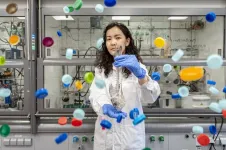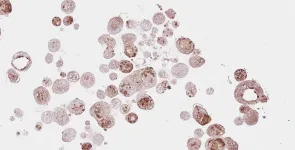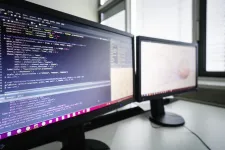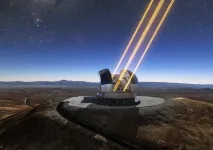(Press-News.org) Meeting the world’s energy demands is reaching a critical point. Powering the technological age has caused issues globally. It is increasingly important to create superconductors that can operate at ambient pressure and temperature. This would go a long way toward solving the energy crisis.
Advancements with superconductivity hinge on advances in quantum materials. When electrons inside of quantum materials undergo a phase transition, the electrons can form intricate patterns, such as fractals. A fractal is a never-ending pattern. When zooming in on a fractal, the image looks the same. Commonly seen fractals can be a tree or frost on a windowpane in winter. Fractals can form in two dimensions, like the frost on a window, or in three-dimensional space like the limbs of a tree.
Dr. Erica Carlson, a 150th Anniversary Professor of Physics and Astronomy at Purdue University, led a team that developed theoretical techniques for characterizing the fractal shapes that these electrons make, in order to uncover the underlying physics driving the patterns.
Carlson, a theoretical physicist, has evaluated high resolution images of the locations of electrons in the superconductor Bi2-xPbzSr2-yLayCuO6+x (BSCO), and determined that these images are indeed fractal and discovered that they extend into the full three-dimensional space occupied by the material, like a tree filling space.
What was once thought of as random dispersions within the fractal images are purposeful and, shockingly, not due to an underlying quantum phase transition as expected, but due to a disorder-driven phase transition.
Carlson led a collaborative team of researchers across multiple institutions and published their findings, titled "Critical nematic correlations throughout the superconducting doping range in Bi2-xPbzSr2-yLayCuO6+x," in Nature Communications.
The team includes Purdue scientists and partner institutions. From Purdue, the team includes Carlson, Dr. Forrest Simmons, recent PhD student, and former PhD students Dr. Shuo Liu and Dr. Benjamin Phillabaum. The Purdue team completed their work within the Purdue Quantum Science and Engineering Institute (PQSEI). The team from partner institutions includes Dr. Jennifer Hoffman, Dr. Can-Li Song, Dr. Elizabeth Main of Harvard University, Dr. Karin Dahmen of the University of Urbana-Champaign, and Dr. Eric Hudson of Pennsylvania State University.
“The observation of fractal patterns of orientational (‘nematic’) domains – cleverly extracted by Carlson and collaborators from STM images of the surfaces of crystals of a cuprate high temperature superconductor – is interesting and aesthetically appealing on its own, but also of considerable fundamental importance in coming to grips with the essential physics of these materials,” says Dr. Steven Kivelson, the Prabhu Goel Family Professor at Stanford University and a theoretical physicist specializing in novel electronic states in quantum materials. “Some form of nematic order, typically thought to be an avatar of a more primitive charge-density-wave order, has been conjectured to play an important role in the theory of the cuprates, but the evidence in favor of this proposition has previously been ambiguous at best. Two important inferences follow from Carlson et al.’s analysis: 1) The fact that the nematic domains appear fractal implies that the correlation length – the distance over which the nematic order maintains coherence – is larger than the field of view of the experiment, which means that it is very large compared to other microscopic scales. 2) The fact that patterns that characterize the order are the same as those obtained from studies of the three dimensional random-field Ising model – one of the paradigrmatic models of classical statistical mechanics – suggests that the extent of the nematic order is determined by extrinsic quantities and that intrinsically (i.e. in the absence of crystalline imperfections) it would exhibit still longer range correlations not just along the surface, but extending deep into the bulk of the crystal.”
High resolution images of these fractals are painstakingly taken in Hoffman’s lab at Harvard University and Hudson’s lab, now at Penn State, using scanning tunneling microscopes (STM) to measure electrons at the surface of the BSCO, a cuprate superconductor. The microscope scans atom by atom across the top surface of the BSCO, and what they found was stripe orientations that went in two different directions instead of the same direction. The result, seen above in red and blue, is a jagged image that forms interesting patterns of electronic stripe orientations.
“The electronic patterns are complex, with holes inside of holes, and edges that resemble ornate filigree,” explains Carlson. “Using techniques from fractal mathematics, we characterize these shapes using fractal numbers. In addition, we use statistics methods from phase transitions to characterize things like how many clusters are of a certain size, and how likely the sites are to be in the same cluster.”
Once the Carlson group analyzed these patterns, they found a surprising result. These patterns do not form only on the surface like flat layer fractal behavior, but they fill space in three dimensions. Simulations for this discovery were carried out at Purdue University using Purdue’s supercomputers at Rosen Center for Advanced Computing. Samples at five different doping levels were measured by Harvard and Penn State, and the result was similar among all five samples.
The unique collaboration between Illinois (Dahmen) and Purdue (Carlson) brought cluster techniques from disordered statistical mechanics into the field of quantum materials like superconductors. Carlson’s group adapted the technique to apply to quantum materials, extending the theory of second order phase transitions to electronic fractals in quantum materials.
“This brings us one step closer to understanding how cuprate superconductors work,” explains Carlson. “Members of this family of superconductors are currently the highest temperature superconductors that happen at ambient pressure. If we could get superconductors that work at ambient pressure and temperature, we could go a long way toward solving the energy crisis because the wires we currently use to run electronics are metals rather than superconductors. Unlike metals, superconductors carry current perfectly with no loss of energy. On the other hand, all the wires we use in outdoor power lines use metals, which lose energy the whole time they are carrying current. Superconductors are also of interest because they can be used to generate very high magnetic fields, and for magnetic levitation. They are currently used (with massive cooling devices!) in MRIs in hospitals and levitating trains.”
Next steps for the Carlson group are to apply the Carlson-Dahmen cluster techniques to other quantum materials.
“Using these cluster techniques, we have also identified electronic fractals in other quantum materials, including vanadium dioxide (VO2) and neodymium nickelates (NdNiO3). We suspect that this behavior might actually be quite ubiquitous in quantum materials,” says Carlson.
This type of discovery leads quantum scientists closer to solving the riddles of superconductivity.
“The general field of quantum materials aims to bring to the forefront the quantum properties of materials, to a place where we can control them and use them for technology,” Carlson explains. “Each time a new type of quantum material is discovered or created, we gain new capabilities, as dramatic as painters discovering a new color to paint with."
Funding for the work at Purdue University for this research includes the National Science Foundation, the Bilsland Dissertation Fellowship (for Dr. Liu), and Research Corporation for Science Advancement.
About the Department of Physics and Astronomy at Purdue University
Purdue Department of Physics and Astronomy has a rich and long history dating back to 1904. Our faculty and students are exploring nature at all length scales, from the subatomic to the macroscopic and everything in between. With an excellent and diverse community of faculty, postdocs, and students who are pushing new scientific frontiers, we offer a dynamic learning environment, an inclusive research community, and an engaging network of scholars.
Physics and Astronomy is one of the seven departments within the Purdue University College of Science. World-class research is performed in astrophysics, atomic and molecular optics, accelerator mass spectrometry, biophysics, condensed matter physics, quantum information science, particle and nuclear physics. Our state-of-the-art facilities are in the Physics Building, but our researchers also engage in interdisciplinary work at Discovery Park District at Purdue, particularly the Birck Nanotechnology Center and the Bindley Bioscience Center. We also participate in global research including at the Large Hadron Collider at CERN, Argonne National Laboratory, Brookhaven National Laboratory, Fermilab, the Stanford Linear Accelerator, the James Webb Space Telescope, and several observatories around the world.
About the Purdue Quantum Science and Engineering Institute (PQSEI)
Located in Discovery Park District, PQSEI fosters the development of practical and impactful aspects of quantum science and focuses on discovering and studying new materials, devices, and basic physical quantum systems that will be suited for integration into tomorrow’s technology. It encourages interdisciplinary collaboration leading to the design and realization of quantum devices with enhanced functionality and performance close to the fundamental limit, aiming to ultimately bring them to a vast community of users. PQSEI faculty work on a broad range of topics in quantum science and engineering including quantum materials and devices, quantum photonics, atomic molecular and optical physics, quantum chemistry, quantum measurement and control, quantum simulation, and quantum information and computing. Finally, PQSEI works to train the next generation of quantum scientists and engineers in order to meet the growing quantum workforce demands.
About Purdue University
Purdue University is a top public research institution developing practical solutions to today’s toughest challenges. Ranked in each of the last five years as one of the 10 Most Innovative universities in the United States by U.S. News & World Report, Purdue delivers world-changing research and out-of-this-world discovery. Committed to hands-on and online, real-world learning, Purdue offers a transformative education to all. Committed to affordability and accessibility, Purdue has frozen tuition and most fees at 2012-13 levels, enabling more students than ever to graduate debt-free. See how Purdue never stops in the persistent pursuit of the next giant leap at https://stories.purdue.edu.
Written by Cheryl Pierce, Communications Specialist
Contributors: Erica Carlson, 150th Anniversary Professor of Physics and Astronomy at Purdue University and Steven Kivelson, the Prabhu Goel Family Professor at Stanford University
Citation: "Critical nematic correlations throughout the superconducting doping range in Bi2−zPbzSr2−yLayCuO6+x"
by Can-Li Song, Elizabeth J. Main, Forrest Simmons, Shuo Liu, Benjamin Phillabaum, Karin A. Dahmen, Eric W. Hudson, Jennifer E. Hoffman & Erica W. Carlson, Nature Communications 14, 2622 (2023)
END
Researchers at Purdue discover superconductive images are actually 3D and disorder-driven fractals
2023-05-12
ELSE PRESS RELEASES FROM THIS DATE:
Save the phages to protect Big Blue
2023-05-12
The plastic era has begun, and for sure, it will last for decades or even longer. Polymer-based materials are almost everywhere, reaching even the deepest regions of the oceans, and their global production is larger than recycling, leading to the generation of tremendous amounts of water pollution with microplastics. These tiny polymer particles not only release chemicals but also reduce the number of bacteriophages. Recently, researchers from the Institute of Physical Chemistry, Polish Academy of Sciences, led by Prof. Jan Paczesny, explored ...
Head and neck cancer organoids as a step towards personalized treatments
2023-05-12
Researchers from the Organoid group (Hubrecht Institute) and UMC Utrecht have developed a biobank with organoids derived from patients with head and neck cancer (HNC). They used this biobank to validate known HNC biomarkers and found that treatment responses in the organoids matched those seen in patients. The results of the study will be published in Med on 12 May 2023 and could aid treatment decisions and discovery of novel therapies for HCN patients in the future.
Head and neck cancer (HNC) is an overarching term used for several types of cancer, including the most ...
Intestinal bacteria influence the growth of fungi
2023-05-12
The bacteria present in the intestine provide information about the quantities of fungi of the potentially disease-causing Candida genus. Among them, and surprisingly, are lactic acid bacteria that are known for their protective effect against fungal infections. The findings of researchers at the Leibniz Institute for Natural Product Research and Infection Biology (Leibniz-HKI) and their collaborative partners from Denmark and Hungary add another piece to the puzzle of understanding the human gut microbiome.
The ...
Researchers discover novel "Shanghai APP" mutation in late-onset Alzheimer's disease, offering new avenues for treatment
2023-05-12
Alzheimer's disease (AD) is a progressive neurodegenerative disorder affecting tens of millions of people worldwide, and it is the most common cause of dementia. Early-onset AD is typically associated with mutations in the genes APP, PSEN1, and PSEN2, leading to a more aggressive form of the disease with atypical symptoms. In contrast, the newly discovered "Shanghai APP" mutation has been linked to LOAD, which affects a larger population of AD patients.
In a study published in Genes & ...
Breakthrough technology: Carbon nanotube membranes with Pd-Cu modification successfully reduce nitrate levels via electrocatalysis
2023-05-12
The adverse effects of excess nitrate in water on human productivity and lives have received increasing attention due to the discharge of industrial wastewater and the overuse of farmland fertilizers. An international team of researchers has conducted an in-depth study of the significant need and challenge of efficient nitrate removal.
Several techniques have been used to eliminate nitrate from water, such as biological denitrification is technologically mature, cost-effective, and widely used. However, biological processes are often sluggish and ...
Samsung Electronics – DGIST, establishment of ”Semiconductor Contracting Department” for fostering semiconductor development talent
2023-05-12
□ DGIST (President Yang Kook) (the following three science and technology institutions) will establish a "Semiconductor Contracting Department" with Samsung Electronics for fostering technical staff specialized in semiconductor manufacturing processes.
□ DGIST closed a business agreement on the 27th (Mon) at DGIST University Center Convention Hall for establishing and operating the Semiconductor Contracting Department, which was attended by Samsung Electronics President Seokwoo Nam and Wanpyo Kim, DGIST President Yang Kook, and other major stakeholders.
□ Owing to the recently increasing global semiconductor demand, safeguarding national competitiveness ...
The DGIST increases clinical diagnosis accuracy through the development of rare cell loss minimization technology.
2023-05-12
□ DGIST (President Yang Kook) Professor Minseok Kim of the Department of Neurobiology and his team developed lossless immunocytochemistry technology, which facilitates analysis of rare cells that present in trace amounts in clinical specimens. The corresponding technology developed together with CTCELLS, Inc. involves the use of an ultra-thin film hydrogel to facilitate fluid exchange while inhibiting cell loss, and a higher preservation rate and reproducibility were achieved compared to existing cell ...
DGIST and Seoul National University signed MOU to develop open innovation business model
2023-05-12
Daegu Gyeongbuk Institute of Science & Technology (DGIST; President Kuk Young) and Seoul National University (President Ryu Hong-lim) signed a memorandum of understanding (MOU) on Wednesday, April 26 to develop an open innovation business model. Under this MOU, Senior Researcher Yun Jin-hyo at the Division of Electronics & Information Systems, DGIST provides consulting services required to develop an open business model to students in the Engineering Project Management Program at the Graduate School of Engineering Practice, Seoul National University. The first seminar was held on the day of the MOU.
□ Senior Researcher ...
Portugal participates in the development of a first-class instrument for the largest telescope in the world
2023-05-12
A research team from the University of Lisbon and University of Oporto (Portugal) participate in the development of METIS (Mid-infrared ELT Imager and Spectrograph). This powerful instrument will equip the largest telescope in the world - the Extremely Large Telescope (ELT) - under construction by the European Southern Observatory (ESO) in Armazones, Chile.
At this critical acceptance stage of the complete and final METIS design, ESO is presenting an illustrative film demonstrating the exceptional capabilities of the instrument. The presentation will take place on May 12, at 4:00pm (CEST).
METIS will detect ...
Prevalence of UTI, bacteremia, and meningitis among febrile infants with SARS-CoV-2
2023-05-12
About The Study: Among 14,400 febrile infants ages 8 to 60 days, the prevalence of urinary tract infection (UTI), bacteremia, and bacterial meningitis was lower for infants who tested positive for SARS-CoV-2, particularly infants ages 29 to 60 days and those with normal inflammatory markers. These findings may help inform management of certain febrile infants who test positive for SARS-CoV-2.
Authors: Paul L. Aronson, M.D., M.H.S., of the Yale School of Medicine in New Haven, Connecticut, is the corresponding author.
To access the embargoed study: Visit our For The Media website at this link https://media.jamanetwork.com/
(doi:10.1001/jamanetworkopen.2023.13354)
Editor’s ...




